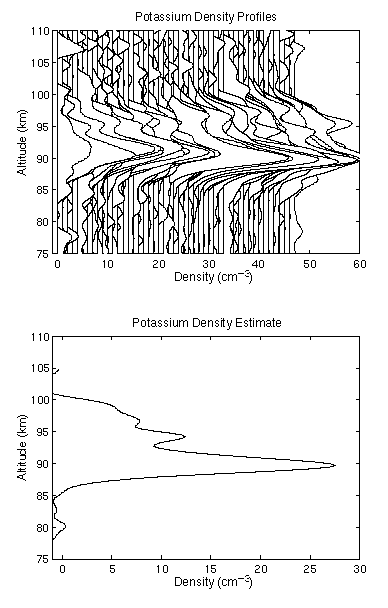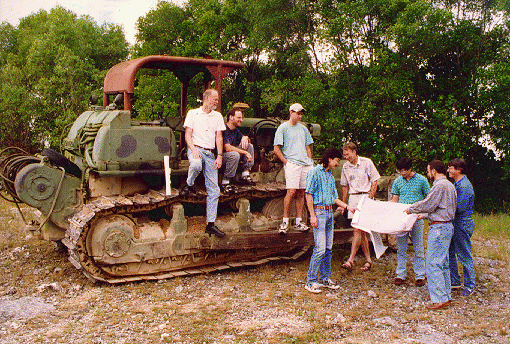
Observations of potassium concentrations over Arecibo using the resonance fluorescence lidar.
Our optical program continued uninterrupted by the upgrade project. In particular, we began to study the features of various metallic species that are resident in the upper mesosphere and lower ionosphere using the alexandrite-based, resonance fluorescence lidar. Metals such as sodium, potassium, iron, and calcium, are deposited by meteor ablation at heights of 80 to 100 km. We presented our first neutral sodium measurements in the last issue of the Newsletter. In the figures below we show more recent and refined observations of potassium, another alkali metal that is prominent near the mesopause.

Observations of potassium concentrations over Arecibo using
the resonance fluorescence lidar.
The figures show the potassium layer measured over Arecibo in August. Both a time series (top) and a single profile (bottom) are displayed. These measurements were made with the injection seeding necessary for narrow spectral width operation but without a precise wavelength locking method, which resulted in an underestimate of the species concentrations. The laser pulse energy was 75 mJ at 770 nm, the wavelength of the potassium resonance line. The fundamental tuning range for the alexandrite laser is 730 to 800 nm, so potassium can be measured within this range without having to Raman shift and frequency double the laser light as we need to do in order to measure sodium. Soon we will improve the laser locking precision and will obtain simultaneous incoherent scatter radar observations of the mesopause region to accompany the resonance lidar observations.
These lidar observations were made by Paul Castleberg (Cornell), Jonathan Friedman (NAIC), and Nina Menezes, an REU summer student from Cornell. To improve the utility of the lidar measurements, Nina and Paul provided the frequency-doubled output from the laser at 385 nm, and added a second receiver channel to measure the scattered sky light at this wavelength. By transmitting and receiving at two different colors (that is, at 770 and 385 nm), it is possible to quantify some of the characteristics of aerosol scatter from the middle atmosphere.
The results of the observations of metals in the upper mesosphere, and the two-color stratospheric aerosol measurements are featured in Paul Castleberg's Ph.D. thesis, which he successfully defended in October. Congratulations, Paul!
Other recent optical observations made at Arecibo consisted of support for two major World Day campaigns in April and October, plus brief periods in July and September. For these studies we measured the thermospheric neutral winds and airglow intensities by observing the atomic oxygen, O(1D), 630-nm emission. Such patrol observations of thermospheric dynamics will provide a consistent database to monitor the long-term conditions of the upper atmosphere.
The April and October World Day periods had a particular CEDAR science focus. These campaigns were given the name MISETA, which is an acronym for Multi-Instrumented Study of Equatorial Thermosphere Aeronomy. That investigation is designed to study equatorial dynamics during equinox periods and the evolution of the phenomena known as spread-F. MISETA campaigns center around the understanding of low latitude ionospheric conditions and heavily rely on the Jicamarca Radio Observatory and other equatorial sites for the observations. At Arecibo, we can provide relevant data from the northernmost latitudinal boundary where intriguing equatorial phenomena might be observed.
Aside from the work of Nina Menezes described earlier, three other REU students worked with members of the atmospheric sciences group this summer. For a summary of their projects, see Jo Ann Eder's article.
After several years of planning, approval for the construction of a new Lidar Laboratory was finally obtained and the construction phase of the project began in October 1996 (see photo below). We expect the lab will be completed and ready for occupancy by mid-spring 1997. We plan to move both the resonance and the Rayleigh lidars to the new building, where additional space will be available for visiting instrumentation as well. The current Optical Lab will continue to house the optical instruments that we use to measure the airglow properties of the upper atmosphere. In addition, three 80-cm diameter telescopes, which will be part of the larger collecting area for the future lidar receiver, have arrived on site and will be installed in the new lab when it is completed.

Coming soon to this hilltop site: a new optical laboratory.
Photo by Tony Acevedo.
Copyright 1996, Cornell University
Return to Arecibo Observatory home page.
Generated with Harlequin WebMaker